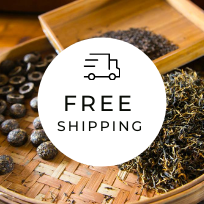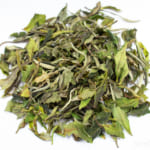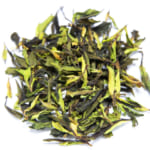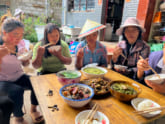- HOME >
- Tea Processing
The Secret of Grading on Ripe Pu-erh Tea
- [2013.07.31] Posted By Akira Hojo
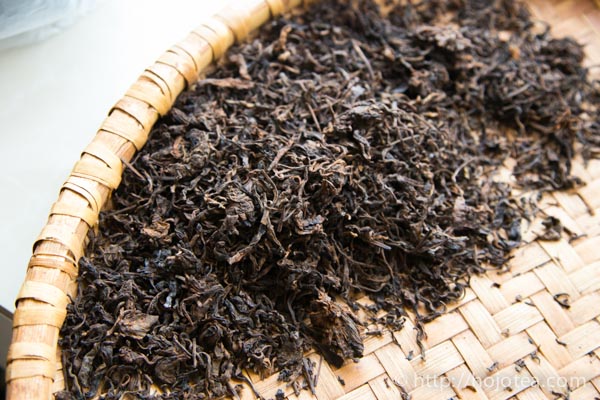
The ripe Pu-erh tea is often classified into various grades. The highest grade of the ripe Pu-erh tea is called the Imperial Grade (宮廷普洱), followed by the Special Grade, the Gift Tea Grade, 1st Grade, 3rd Grade, 5th Grade, 7th Grade, 8th Grade and till 10th Grade. However, the grading of ripe Pu-erh tea does not accurately reflect the quality of the tea. Thus, I would like to share more about the details as follow.
Ripe Pu-erh tea is processed from the leaves that contain one bud and two to three leaves
The raw material for the ripe Pu-erh tea is the raw Pu-erh tea which composes of 1 bud and 2-3 leaves. Therefore, the production of ripe Pu-erh tea involves the fermentation of raw Pu-erh tea with some micro-organisms. Basically, both the raw and ripe Pu-erh tea leaves are of roughly the same appearance, except for the ripe Pu-erh, the tea leaves are slightly more fragmented into smaller sizes due to the mixing and other handling during the production. After the fermentation, the leaves are then called mao-cha in Chinese.
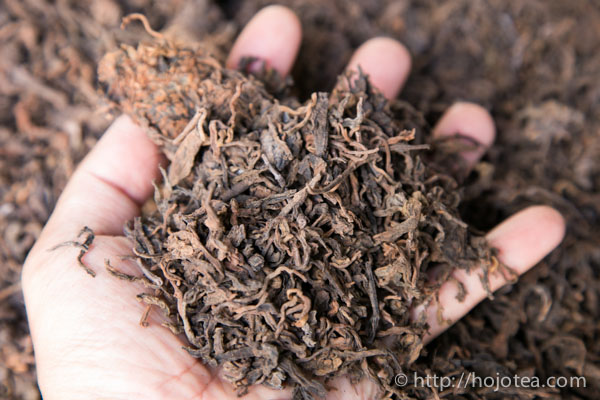
The grading of ripe Pu-erh tea is carried out with sieving
The mao-cha of ripe Pu-erh tea is occasionally compressed as it is. However, in most cases, the mao-cha is classified into various grades where the grading is carried out mainly using a sifter or sometimes, other type of sorting equipment such as a gravity separator. The mao-cha of ripe Pu-erh tea is further classified into groups such as bud, leaf, stem and so on where each fraction of leaves collected during sorting process are classified into different grades. The higher grades of ripe pu-erh tea contain more buds, while the lower grades have more leaves in bigger sizes.

The tea on the left is the mao-cha and the one on the right is the special grade collected after sieving.
The grading of the ripe Pu-erh tea does not mean identifying the tea’s quality
As mentioned, out of many grades, the finest grade is called the Imperial Grade that consists of mostly the tea buds where the price is usually higher. The colour of the tea buds are of golden colour and it looks gorgeous. But, on the contrary, the grades of ripe pu-erh tea that consist of many stems are usually considered as a lower quality tea. However, we should not forget that all grades of tea originate from the same material and the grading of ripe Pu-erh tea has nothing to do with the quality but the cup characteristics. In addition, different parts of the leaf produce different intensity of body, after taste and flavour. Somehow, the satisfaction of enjoying a cup of tea does not depend on its proportion to the grading. For example, the imperial Pu-erh tea is the most expensive tea but it does not mean it will produce the best drinking feeling. The imperial Pu-erh produces a very delicate and soft mouth feeling, yet it emits a lighter body and after taste when compared to the rest of the grades.
Regardless of which country, there are a number of customers who tend to judge the tea quality based on its appearance since it is an easier way; in other words, where there are ‘more golden tips, the better the quality’, is what they usually presume. As a result, the present grading method has developed due to these trends. In any case, the quality of tea should be judged from the after taste, body and flavour, rather than just the appearance.
Imperial Grade
The imperial grade is called Gong Ting in Chinese. If you are interested in this grade of tea, please try our “Gong Ting Jing Hao”. Jing Hao means “Golden Bud” in Chinese.
Related Articles
How to get the latest update on HOJO Tea?
1. Follow Twitter, 2. Click "Like" on Facebook, and 3. Subscribe in newsletter. You can have the latest tea news from HOJO Tea.
 Subscribe the Newsletter to enjoy the privileges
Subscribe the Newsletter to enjoy the privileges- You may receive a free sample upon purchase, or you may have the priority to purchase special products. So please remember to subscribe our newsletter as well as the social network.
- Yunnan Chun Jian Green Tea from High Mountain Gardens
- Yunnan Chun Jian Green Tea is now available.This tea is made from naturally grown leaves harvested from high mountain gardens at 2100m above sea level. It has a rich, long-lasting lingering aftertaste, comparable to raw Pu-erh tea. Yunnan as a Distinctive Tea Growing Region Over the past 20 years, we have explored a wide range …
- Limited Loose Leaf Release of 2025 Da Xue Shan Wild Raw Pu-erh Tea
- We have released the 2025 loose-leaf version of Da Xue Shan Wild Raw Pu-erh Tea.This tea comes from wild tea trees that grow naturally in the high mountains of Yunnan Province, at elevations above 2000 meters. This year, we were only able to secure a small quantity for retail, and the current release is available …
NEW ARTICLES
 Yunnan Chun Jian Green Tea from High Mountain Gardens
Yunnan Chun Jian Green Tea from High Mountain Gardens- Yunnan Chun Jian Green Tea is now available.This tea is made from naturally grown leaves harvested from high mountain gardens at 2100m above sea level. It has a rich, long-lasting lingering aftertaste, comparable to raw Pu-erh tea. Yunnan as a Distinctive Tea Growing Region Over the past 20 years, we have explored a wide range …
 Limited Loose Leaf Release of 2025 Da Xue Shan Wild Raw Pu-erh Tea
Limited Loose Leaf Release of 2025 Da Xue Shan Wild Raw Pu-erh Tea- We have released the 2025 loose-leaf version of Da Xue Shan Wild Raw Pu-erh Tea.This tea comes from wild tea trees that grow naturally in the high mountains of Yunnan Province, at elevations above 2000 meters. This year, we were only able to secure a small quantity for retail, and the current release is available …
 2025 Da Xue Shan Wild White Tea Now Available from Yunnan
2025 Da Xue Shan Wild White Tea Now Available from Yunnan- The 2025 harvest of Da Xue Shan Wild White Tea is now available. Crafted from truly wild Camellia taliensis trees growing naturally in the high-altitude forests of Yunnan, this tea offers a purity and character unique to its origin. This year’s unusually dry climate during the withering season was ideal, resulting in a floral and …
 Why Do Some Teas Taste Astringent? Exploring the Causes and Mechanisms of Astringency
Why Do Some Teas Taste Astringent? Exploring the Causes and Mechanisms of Astringency- Tea can range from having no noticeable astringency to possessing a very strong one. What causes this astringency? This article explores the causes and mechanisms behind astringency in tea. Causes of Astringency Astringency arises from the binding of tea components to proteins in the oral cavity, creating a sensation of tightness or dryness. The tongue …
 The Impact of Heat Sources on Tea Flavor
The Impact of Heat Sources on Tea Flavor- It is widely recognized that the material of a kettle plays an important role in shaping the taste of water for brewing tea. Yet, an often overlooked but equally significant factor is the type of heat source used to boil the water. Different heat sources, whether gas, electric, charcoal, or wood fire, can impart distinct …
 New Release of High Mountain White Tea
New Release of High Mountain White Tea- We are pleased to introduce our High Mountain White Tea, sourced from a unique tea garden with two key features: 1. Located at an altitude of 2200-2300m2. Completely wild and untended The ideal natural conditions of this garden result in tea of exceptional quality, offering a pure and gentle, nourishing taste. High Altitude and Wild …
 New Release of Da Xue Shan Wild White Tea 2024
New Release of Da Xue Shan Wild White Tea 2024- We have released the 2024 Da Xue Shan Wild White Tea Loose Leaf. This tea was produced under our direct supervision during our stay in Yunnan Province, ensuring meticulous production management on site. Definition of Wild Tea in Yunnan Province People in Yunnan strongly associate Camellia taliensis with wild tea, regardless of where it is …
 New Release of Wild Pu-erh Jasmine Pearl
New Release of Wild Pu-erh Jasmine Pearl- Out of curiosity, we decided to create a jasmine tea based on Da Xue Shan Wild Raw Tea. This resulted in an exceptionally rare tea, not only in Japan but also in China. Custom Production Network for Jasmine Tea At our store, we source various types of base teas from different regions during the spring. …
 2024 Overview: Our Yunnan White Tea Quality, Process, and Weather Insights
2024 Overview: Our Yunnan White Tea Quality, Process, and Weather Insights- One of the teas we’ve been focusing on in Yunnan Province is white tea. Historically white tea has been produced in both Fujian Province and Yunnan Province for a long time. While white tea from Fujian Province is well-managed during processing, we are dissatisfied with the quality of the raw materials due to the use …
 Yunnan’s Hospitality Culture: Expressed Through Meals
Yunnan’s Hospitality Culture: Expressed Through Meals- In China, as a form of greeting, it’s common to say “你吃饭了吗?” which means “Have you eaten?” However, in Yunnan Province, the phrase “吃饭” is often used in various situations, more like “Eat, eat,” serving as an invitation to share a meal. Yet, with prolonged exposure to Yunnan, one comes to understand that these meal …
Shop Info

Address:Lot No. T-215, 3rd Floor, The Gardens Mall, Mid Valley City, Lingkaran Syed Putra, 59200 Kuala Lumpur
Tel: +603-2287-4537
Business Hour: 10am to 10pm
Category
- New Arrival at HOJO Online Shop
- Featured Articles
- Newsletter
- Types of Tea
- Origin of Tea
- Teapot and Tea Equipment
- Tea Column
- How to enjoy tea
- Tea Processing
- How to choose quality tea
- Tea constituents and functional effect
- Safety of Tea
- Foods
- Tea Business Operation
- Hobby and Outdoor Activity
- Ranking of Tea
- Video
- FAQ
- Media Release
Profile

- AKIRA HOJO
- I invite you to experience my tea selections.I was born in Nagano, Japan. In university, I studied agricultural chemistry, and I have the master degree in food science. I worked in Japanese food industry for 10 years. I involved in R&D, QC and QA. As a factory manager, I implemented ISO9000 series and managed the factory.
- The Art of Tea Magazine
- We posted the article on “The Art of Tea Magazine No.9, the magazine is published in Taiwan. We featured some scientific view about the tetsubin
- New Straits Times
- The Malaysian National Newspaper, New Straits Times featured HOJO Tea on 17-Oct-2007.




